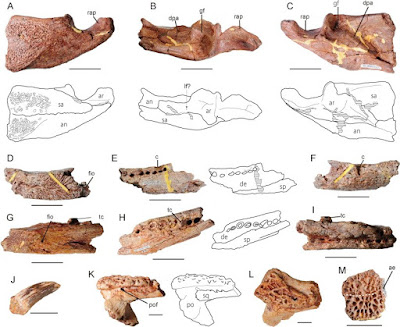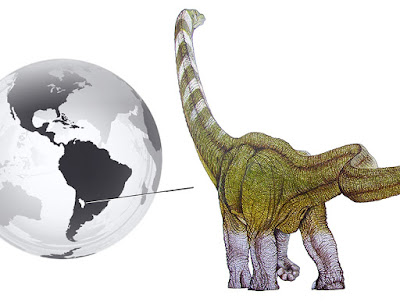Abstract
We describe remains of a new crocodyliform found from the Lower Cretaceous (Aptian) Khok Kruat Formation, northeastern Thailand. Remains consist of two caudal ends of mandibles, two rostral symphyseal parts of right rami of mandibles, a dorsal part of postorbital, a cranial end of squamosal and one osteoderm. Phylogenetic analyses supported inclusion of this crocodyliform into the Eusuchia as it shares several morphological characters with other eusuchians, such as a dorsocaudally oriented retroarticular process, smooth lateral surface of the caudoventral region of mandible, and a craniocaudally oriented ridge on the dorsal surface of retroarticular process. The shape of symphyseal region showed this crocodyliform had a longirostrine snout shape, which is uncommon in early eusuchians. Finding of this crocodyliform draws back the oldest record of Asian eusuchians, which was Tadzhikosuchus, approximately 30 million years and it is the only Mesozoic eusuchian found in East and Southeast Asia.
Keywords: Khok Kruat Formation; Aptian; Eusuchia; Thailand; Asia
Systematic paleontology
CROCODYLIFORMES Hay, 1930
MESOEUCROCODYLIA Whetstone and Whybrow, 1983
NEOSUCHIA Clark, 1986
EUSUCHIA Huxley, 1875
gen et sp. indet.
Conclusions:
Morphological comparison and phylogenetic analysis showed the Ban Saphan Hin crocodyliform is a member of Eusuchia. But due to its fragmentary nature its phylogenetic position within Eusuchia is currently uncertain. The Ban Saphan Hin crocodyliform indicates longirostrine snout shape evolved during the early stage of eusuchian, which is probably independent from that of gavialoids. Moreover it draws back the oldest record of Asian eusuchians from the Santonian, Tadzhikosuchus found from Tadzhikistan, to the Aptian, approximately 30 million years ( Storrs and Efimov, 2000), and it is the only Mesozoic eusuchian found in East and Southeast Asia. This situation reflects the patchy fossil record of Mesozoic crocodyliform in these areas. The Late Cretaceous crocodyliforms of East Asia were reported only from Mongolia (Storrs and Efimov, 2000; Turner, 2015). Further sampling effort is required to reveal the complex evolutionary history of Asian Mesozoic neosuchians.
Tai Kubo, Masateru Shibata, Wilailuck Naksri, Pratueng Jintasakul and Yoichi Azuma. 2017. The Earliest Record of Asian Eusuchia from the Lower Cretaceous Khok Kruat Formation of northeastern Thailand. Cretaceous Research. In Press. DOI: 10.1016/j.cretres.2017.05.021
---------------------------------------------------------------
روابط التحميل والمشاهدة، الروابط المباشرة للتحميل
او
شاهد هذا الفيديو القصير لطريقة التحميل البسيطة
كيف تحصل على مدونة جاهزة بآلاف المواضيع والمشاركات من هنا
شاهد قناة منتدى مدونات بلوجر جاهزة بألاف المواضيع والمشاركات على اليوتيوب لمزيد من الشرح من هنا
رابط مدونة منتدى مدونات بلوجر جاهزة بآلاف المواضيع والمشاركات في أي وقت حــــتى لو تم حذفها من هنا
شاهد صفحة منتدى مدونات بلوجر جاهزة بألاف المواضيع والمشاركات على الفيس بوك لمزيد من الشرح من هنا
شاهد صفحة منتدى مدونات بلوجر جاهزة بألاف المواضيع والمشاركات على الفيس بوك لمزيد من الشرح من هنا
تعرف على ترتيب مواضيع منتدى مدونات بلوجر جاهزة بآلاف المواضيع والمشاركات (حتى لا تختلط عليك الامور) من هنا
ملاحظة هامة: كل عمليات تنزيل، رفع، وتعديل المواضيع الجاهزة تتم بطريقة آلية، ونعتذر عن اي موضوع مخالف او مخل بالحياء مرفوع بالمدونات الجاهزة بآلاف المواضيع والمشاركات، ولكم ان تقوموا بحذف هذه المواضيع والمشاركات والطريقة بسيطة وسهلة. ــــــــــــــــــــــــــــــــــــــــــــــــــــــــــــــــــــــــــــــسلامـ.


















